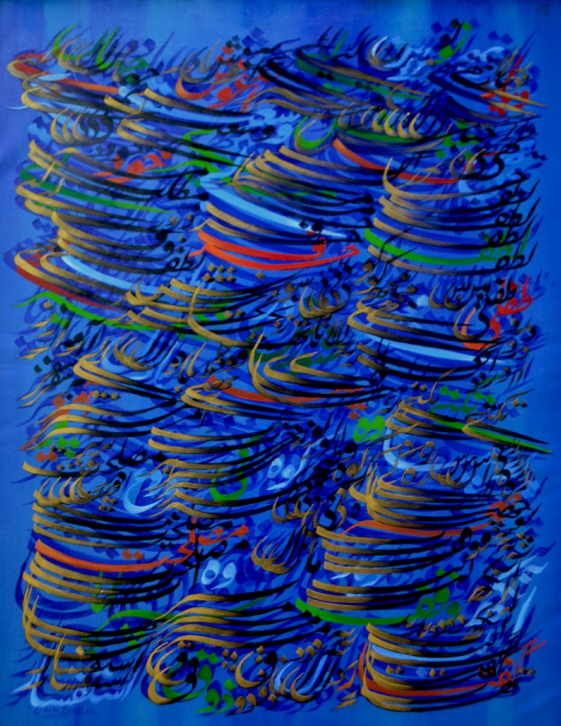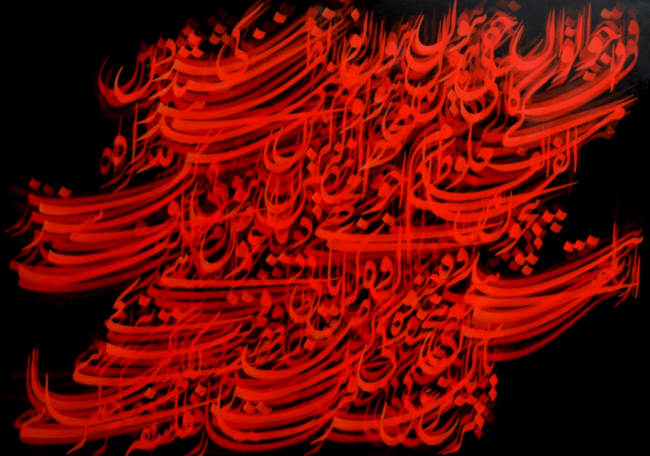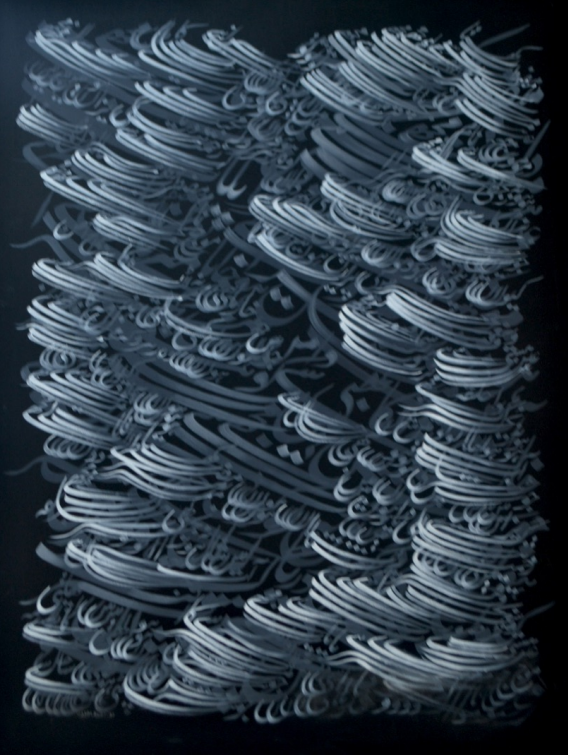A Solo Show titled ‘Aks-e-Mashriq’ by Qasim Bugti at Ejaz Art Gallery, Lahore Upon entering the gallery space, displaying the works of Qasim
A Solo Show titled ‘Aks-e-Mashriq’ by Qasim Bugti at Ejaz Art Gallery, Lahore
Upon entering the gallery space, displaying the works of Qasim Bugti, one could feel the space resonate with the silent eloquence of Urdu calligraphy in the exhibition titled “Aks-e-Mashriq.” Bugti, steeped in the rich traditions of our artistic heritage, explores the intricate dance between calligraphy and miniature art, inviting the audience into a realm where precision, complexity, and the pursuit of knowledge converge. This exhibition, a celebration of Nastaliq script and the disciplined practice of mashq, unveils a captivating tapestry of divine expression that is both visually striking and spiritually enriching.
The title of the exhibition ‘Aks-e-Mashriq’ comes off as a poetic elucidation of Qasim Buqti’s own journey, establishing the foundation for the exhibition. The Nastaliq script, meticulously practiced through unwavering dedication, becomes the medium through which Buqti communicates a profound connection to the divine. The inherent beauty and delicacy of calligraphy are not just visual elements but serve as conduits for conveying profound spiritual messages, akin to a sacred manifestation.
A distinctive influence emerges in the artist’s work, drawing parallels to mystics, in his case: Iqbal. The echoes of Iqbal’s philosophical poetry reverberate throughout the exhibition, demanding from the viewer a commitment to repeated engagement and contemplation. Buqti’s adherence to the Nastaliq script becomes a vessel for decoding the rules within his work, mirroring the intricate unraveling of Iqbal’s reflective verses.
Bugti’s infusion of mysticism into the artistic process is palpable. The artist’s homage to Sufism, deeply rooted in philosophical thoughts and closely entwined with religious beliefs, serves as a thematic undercurrent throughout the exhibition. Each stroke of the calligraphic pen becomes a step on the spiritual journey, a path that meanders through the canvas and invites the viewer to embark on their own contemplative voyage.
The thematic resonance with Iqbal’s philosophical poems is evident, requiring the audience to reflect repeatedly on the mathematical precision embedded within the verses. This repetitive engagement echoes the Sufi path, emphasizing the necessity of revisiting and reliving certain experiences to unravel their deeper meaning. In Sufism, repetitiveness holds significant spiritual and symbolic meaning, and it is often intertwined with various practices and rituals.
Mashq, as a practice, is not only about technical skill but also about seeking a spiritual connection. Calligraphers often see their work as a form of worship and a means of expressing devotion to the divine. The emphasis on repetition serves to deepen the practitioner’s connection with the divine, promote spiritual discipline, and facilitate a transformative journey. In Bugti’s case this mashq provides a structured framework for him to engage in transformative practices that lead to a deeper understanding of himself and a closer relationship with God.
On Bugti’s canvases, the interweaving of Nastaliq and Iqbal’s poetry is a harmonious dance, where each letter becomes a vessel for the poet’s profound thoughts, and each word is a brushstroke conveying the essence of Sufi wisdom.
As one moves through the exhibition, the thoughtful inner pleasure experienced by the artist becomes contagious. The vibrancy of the colors, the fluidity of the script, and the thoughtful composition coalesce to create a sensory experience that transcends the visual. Each piece invites the viewer to partake in the artist’s spiritual exploration, offering a glimpse into the divine through the language of calligraphy.
Through his works, Bugti can be seen being engaged in meticulous exercises to master the intricacies of his chosen script, Nastaliq, along with the focus on the technical aspects, including brush control, letter proportions, and the harmonious arrangement of script elements. Bugti embraces the nuances of Nastaliq with unparalleled finesse. The delicate yet commanding strokes of this script come alive in each piece, a testament to the artist’s mastery acquired through diligent practice and a commitment to the art of mashq. The intricate dance of letters reveals not only technical prowess but a profound connection with the spiritual underpinnings of the calligraphic tradition.
What distinguishes Bugti’s work is the daring and varied color palette employed. From the timeless elegance of black and white to the bold and vibrant hues that splash across the canvas, each piece is a symphony of colors. The artist’s ability to seamlessly integrate such a diverse range of tones speaks to a keen sense of aesthetic balance and an adventurous spirit.
Qasim Bugti has succeeded in creating an exhibition that transcends the boundaries of traditional calligraphy. It is an immersive experience where the soulful verses of Iqbal come to life through the medium of Nastaliq, and the disciplined practice of mashq becomes an outlet for spiritual expression. The fusion of varied colors, masterful script, and poetic inspiration makes this collection a profound exploration of the divine within the art of calligraphy.
The exhibition titled “Aks-e-Mashriq” by Qasim Bugti opened at Ejaz Art Gallery, Lahore on the 1st of December, 2023.




COMMENTS